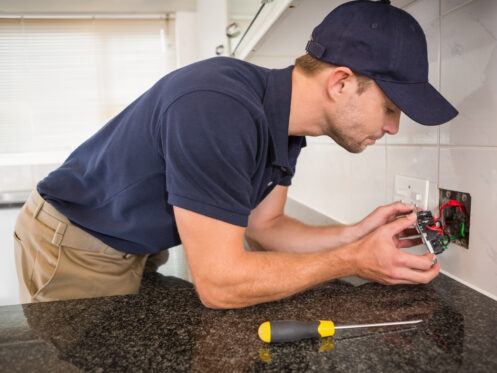Prioritizing your home’s electrical system is vital to the security, efficiency, and tranquility of your house. Properly maintaining the system reduces the risk of fire, protects you and the home against electrical shocks, and ensures adherence to safety regulations. Plus, when the electrical system is in good working order, appliances can run reliably with less energy and unexpected malfunctions are less likely to occur. Scheduling annual inspections is one of the best ways to safeguard the electrical system. Licensed electricians will perform several tasks that benefit your home in at least 14 ways.
1. Detect Any Unauthorized Modifications
During their annual inspections, electricians look for signs of unlawful alterations, such as new wiring, circuits, or components. Making unauthorized changes puts your safety at risk and breaks electrical regulations. Ensuring compliance with rules and protecting the electrical system from malfunctions all depend on detecting and fixing these changes.
2. Detect Frayed or Damaged Wires
Electricians examine the home’s wiring for breakage, fraying, and other symptoms of wear. The process begins with a visual inspection and may entail the use of special instruments, such as multimeters. Damaged wiring can cause fires and electrical failures. To restore the electrical system’s dependability and safety, electricians will determine whether to repair or replace the damaged wiring.
3. Assess the Condition of Outlets
As part of their routine inspections, electricians look for grounded outlets, symptoms of overheating, and loose connections in electrical outlets. Problems like frayed wires, broken outlets, or outdated parts are common. To fix outlet problems, electricians inspect the wiring to assess the amount of damage. This helps them decide whether to perform a repair or replacement. It could be that a wire is loose. If this is the case, the electrician will simply tighten any loose screws and wires. When an outlet doesn’t receive power, there may be an issue with the circuit breaker. For outdated outlets, the electrician will likely suggest upgrading them with new ones.
4. Identify Outdated Components
Electrical systems have lots of other parts that can easily become outdated after several years. These parts include fuse boxes, grounding systems, electrical panels, conduit and conductor insulation, switches, and circuit breakers. With annual inspections, electricians can easily find any outdated components and replace them, making the system more secure and efficient. Upgrading to more contemporary components also reduces electrical dangers and ensures compliance with current regulations.
5. Verify Proper Grounding
Electricians examine the home’s grounding, grounding electrodes, and conductors during yearly inspections. To ensure a low-impedance connection to the ground, they use high-tech sensors to measure resistance. The prevention of electrical shock and the proper functioning of protective equipment depends on proper grounding. If electricians find evidence of faulty grounding, they may replace or add grounding electrodes as needed to make the electrical system safe and dependable.
6. Check for Overloaded Circuit
Electricians look for signs of overloaded circuits by analyzing load estimates, inspecting circuit ratings, and detecting overheating via thermal imaging. Overloaded circuits result in a higher risk of electrical fires, equipment damage, and other safety issues. Electricians prevent these hazards by making sure circuits aren’t carrying more current than they can manage.
7. Identify Potential Shock Hazards
Electricians look for potential shock dangers by testing various electrical components and appliances. Insulation damage, exposed wiring, and poor grounding are all things they look for. Preventing electrical injuries requires immediate attention to potential shock dangers, particularly in damp environments. To make your home safer against shocks, an electrician may suggest adding GFCIs and making sure your insulation is up to code.
8. Evaluate the Functionality of GFCI Outlets
Electricians check GFCI outlets for operation by pressing the “Test” and “Reset” buttons. They do this to make sure the GFCI can quickly shut off electricity in the event of a ground fault.
9. Ensure the Safety of Connected Appliances
An electrician will check your appliances’ power cords, connectors, and grounding to make sure they have secure connections. Among the most common appliances that they check are HVAC systems, washing machines, dishwashers, microwaves, refrigerators, and ovens. If your home uses smart technology, the electricians will check the various appliances that connect to the home’s internet connection. This may include heating and cooling systems, thermostats, and whole-home air purification systems.
10. Assess Outdoor Electrical Systems
Most homes have several outdoor electrical components that electricians check during annual inspections. Among the most common are outdoor outlets and exterior lighting fixtures. Factors such as quality, weather exposure, and maintenance all affect how long outdoor outlets and lighting fixtures last. Many homes also have electric fences and sprinkler systems. During annual inspections, electricians check these parts for weather-related damage and normal wear and tear. When inspecting electric fences, electricians check the wiring, insulators, and energizers. For electric sprinkler systems, they inspect the wiring and controls.
11. Check for Voltage Irregularities
Electricians conduct inspections using multimeters and voltage testers to look for any voltage anomalies. A safe and constant voltage is paramount to avoid electrical fires, equipment damage, and improper appliance operation. To detect changes or anomalies, electricians take voltage readings from outlets, circuit breakers, and main electrical panels. Electricians typically take several steps to resolve a bad voltage reading during an inspection. This includes isolating the issue, checking connections, inspecting circuit breakers, and testing voltage at the main panel. It may also involve checking for overloading and inspecting external factors like utility line issues.
12. Identify Potential Sources of Energy Waste
Annual electrical inspections help homeowners identify sources of energy waste, such as old, inefficient appliances, lights, and insulation. Upgrading these components with newer, more energy-efficient units can significantly reduce energy waste. This preventative measure encourages a greener house by increasing energy efficiency and decreasing electricity bills.
13. Detect Signs of Electrical Corrosion
Electricians detect corrosion in the electrical system during annual inspections, which is important for reducing equipment failure and fire threats. When they find corroded cables, terminals, or parts, they fix them right away. Correcting corrosion requires removing corroded components, coating them with anti-corrosion treatments, and putting in the necessary insulation. Homeowners can help prevent corrosion in the electrical system by contacting a plumber right away any time there is a water leak. It may also help to use a dehumidifier to remove excess moisture from the home.
14. Identify Potential Fire Hazards
During an inspection, electricians check the electrical panels, outlets, and wiring for any indications of damage or wear. They look for any fire threats, make sure the grounding is correct, and evaluate the state of the circuit breakers. Common fire hazards found and addressed by electricians during maintenance include frayed or damaged wiring, overloaded circuits, outdated components, improperly installed outlets, and faulty circuit breakers.
HR Phoenix makes it easy to access licensed electricians in Colleyville, TX. We provide both residential and commercial services, including electrical panel installations and EV charging station repairs. We also offer generators and plumbing services. Give us a call right away to schedule an electrical inspection for your home.


